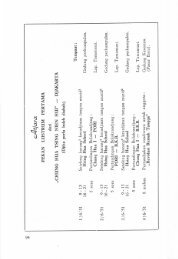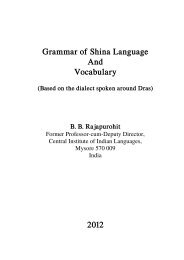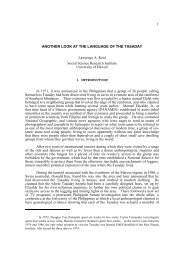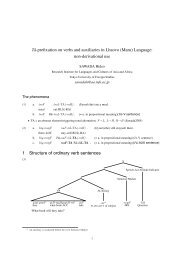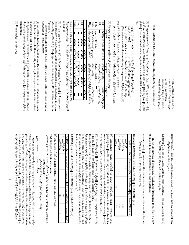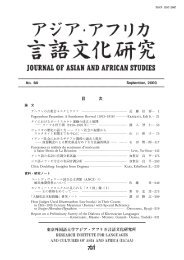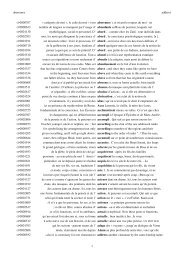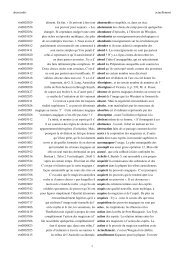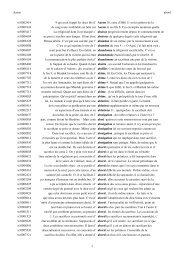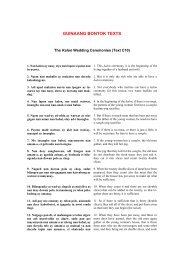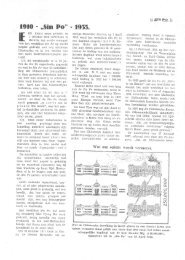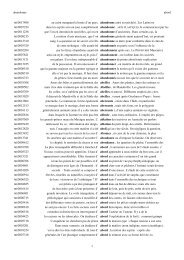Tonal Notation of Indic scripts in Mainland Southeast Asia
Tonal Notation of Indic scripts in Mainland Southeast Asia
Tonal Notation of Indic scripts in Mainland Southeast Asia
Create successful ePaper yourself
Turn your PDF publications into a flip-book with our unique Google optimized e-Paper software.
treated as rhymes with a f<strong>in</strong>al consonant cluster. However, Mon script<br />
provided no device for it, because there has been no f<strong>in</strong>al cluster <strong>in</strong> Mon.<br />
Mon script utilizes the vowel killer obligatorily to transcribe f<strong>in</strong>al<br />
consonants 11 . Therefore, the existance <strong>of</strong> a vowel killer implies that<br />
the syllable is ‘closed’ there. Burmese seems to have taken over the<br />
implication coupled with the obligatory use <strong>of</strong> the vowel killer, because<br />
Burmese did not use two concatenated consonant letters with a vowel<br />
killer each to achive the ‘graphical f<strong>in</strong>al cluster’. Instead, they achieved<br />
it by the comb<strong>in</strong>ation <strong>of</strong> a vowel killer with a ligature.<br />
Most <strong>of</strong> <strong>Indic</strong> <strong>scripts</strong> have a set <strong>of</strong> ligatures, i.e. comb<strong>in</strong>ations <strong>of</strong><br />
consonantal glyphs transcrib<strong>in</strong>g a consonant cluster. In <strong>Indic</strong> <strong>scripts</strong> <strong>of</strong><br />
<strong>Southeast</strong> <strong>Asia</strong>, consonantal glyphs <strong>in</strong> a comb<strong>in</strong>ation are usually dist<strong>in</strong>ct<br />
from each other, 12 and stacked vertically. 13 The <strong>in</strong>herent vowel <strong>of</strong> a letter,<br />
so to speak, is ‘killed’ by the addition <strong>of</strong> a subscript letter. Ligatures<br />
are used to transcribe <strong>in</strong>tersyllabic clusters <strong>of</strong> Sanskrit/Pāli loanwords,<br />
and the <strong>in</strong>trasyllabic clusters.<br />
Old Mon script also has the device <strong>of</strong> ligatures to transcribe consonant<br />
clusters. 14 Some comb<strong>in</strong>ations are the <strong>in</strong>novation <strong>of</strong> Mon script<br />
to transcribe clusters unique to the language, not found <strong>in</strong> Sanskrit/Pāli<br />
loanwords.<br />
(17) l N im¸ {l=ngim’} ‘thousand’ (Rajakumar: 2.)<br />
sťát˘ {s=cu ti} ‘die’ (hypothetical form) (Rajakumar: 11.)<br />
cÁAm¸ {c=naam’} ‘year’ (Rajakumar: 2.)<br />
kÆ<strong>in</strong>’<br />
{k=m<strong>in</strong>’} ‘rule’ (Rajakumar: 10.)<br />
m ân’ {m=Suun’} ‘five’ (Shwezigon A: 31.)<br />
•<br />
k a im¸ {k=@im’} ‘smile’ (Shwezigon A: 20, 21.)<br />
ec a N¸ {c=@eng’} ‘other’ (Rajakumar: 31.)<br />
es a Ar’ {s=@or’} ‘cause’ (hypothetical form) (Shwezigon B: 52.)<br />
As seen <strong>in</strong> the above examples, a vowel symbol attached to a ligature<br />
always modifies the lower glyph <strong>of</strong> it. The same th<strong>in</strong>g must apply to a<br />
vowel killer. When a vowel killer {-’} attached to a ligature conta<strong>in</strong><strong>in</strong>g<br />
a subscript {@}, the <strong>in</strong>herent vowel <strong>of</strong> upper consonant letter is ‘killed’<br />
by the addition <strong>of</strong> the subscript, and the <strong>in</strong>herent vowel <strong>of</strong> subscript is<br />
‘killed’ by {-’}. As a result we get a ‘graphical f<strong>in</strong>al cluster’. Compare<br />
the below examples from OM and OB.<br />
(18)<br />
12



